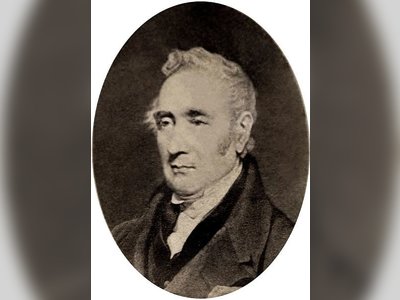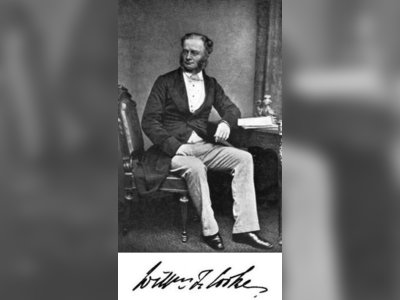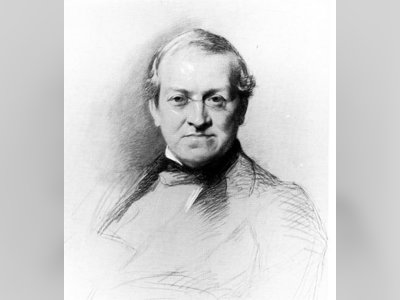British Heritage
Remember, Cherish, Learn.
beta
Richard Trevithick - The Steam Locomotive
Contribution to British Heritage.
Richard Trevithick, a prominent British inventor and mining engineer, made significant contributions to British heritage through his pioneering work in the development of steam-powered road and rail transport. Born on 13th April 1771 in Cornwall, Trevithick grew up in the heart of one of Britain's rich mineral-mining areas, which deeply influenced his interests from an early age. He went on to create two groundbreaking innovations that transformed transportation and revolutionized the industrial landscape of Britain and beyond.
His first major achievement was the invention of the high-pressure steam engine, which he developed around 1797. This revolutionary technology allowed steam engines to operate more efficiently and with higher power, making them suitable for locomotion. Until then, steam engines were primarily used for stationary applications and were inefficient for moving vehicles.
The second and most iconic contribution of Trevithick was the creation of the world's first working railway steam locomotive. On 21st February 1804, his unnamed steam locomotive successfully hauled a train along the tramway of the Penydarren Ironworks in Merthyr Tydfil, Wales, marking the birth of the railway transportation era.
Trevithick's innovations laid the foundation for the development of steam locomotion, which had a profound impact on British society and industry. Steam-powered railways facilitated the efficient transportation of goods and people, boosted industrial productivity, and accelerated economic growth. It also led to the expansion of railways across Britain and beyond, connecting previously isolated regions and fostering a sense of national unity.
Richard Trevithick's legacy as a pioneering inventor and engineer endures in British history. His work revolutionized transportation and engineering practices, leaving a lasting impact on the development of railways and the Industrial Revolution.
His invention of the high-pressure steam engine paved the way for more efficient and powerful steam engines, which became the backbone of the Industrial Revolution. The adoption of high-pressure steam engines in various industries, including mining and manufacturing, significantly increased productivity and contributed to Britain's economic prosperity during the 19th century.
However, Trevithick's most enduring legacy lies in the field of transportation. His successful demonstration of the first working railway steam locomotive laid the groundwork for the expansion of railways across Britain and the world. Steam-powered locomotives became a symbol of progress and modernity, changing the way people and goods moved. The railway networks, which grew exponentially over the following decades, transformed society by connecting cities and towns, enabling the mass movement of people, goods, and raw materials, and fostering economic growth.
The impact of railways on British culture and society is immeasurable. They brought people closer together, allowed for easier and faster travel, and helped facilitate the growth of urban centers. The railways also played a vital role in the expansion of trade and commerce, boosting the British economy and solidifying its position as an industrial powerhouse.
Richard Trevithick's contributions to British heritage are twofold. Firstly, his pioneering work in the development of high-pressure steam engines revolutionized various industries, including mining and manufacturing, driving Britain's industrialization and economic growth. Secondly, his creation of the first working railway steam locomotive sparked the railway revolution, connecting the nation and shaping its transportation landscape.
Trevithick's innovations and inventions remain an integral part of British heritage, and his legacy continues to inspire generations of engineers and inventors. His vision and determination to harness the power of steam have left an indelible mark on British history, making him a true icon of the Industrial Revolution and a key figure in the nation's technological progress. The development of steam locomotion, initiated by Trevithick, not only transformed transportation but also laid the groundwork for future advancements in engineering and technology, leaving an enduring legacy in the annals of British heritage.
His first major achievement was the invention of the high-pressure steam engine, which he developed around 1797. This revolutionary technology allowed steam engines to operate more efficiently and with higher power, making them suitable for locomotion. Until then, steam engines were primarily used for stationary applications and were inefficient for moving vehicles.
The second and most iconic contribution of Trevithick was the creation of the world's first working railway steam locomotive. On 21st February 1804, his unnamed steam locomotive successfully hauled a train along the tramway of the Penydarren Ironworks in Merthyr Tydfil, Wales, marking the birth of the railway transportation era.
Trevithick's innovations laid the foundation for the development of steam locomotion, which had a profound impact on British society and industry. Steam-powered railways facilitated the efficient transportation of goods and people, boosted industrial productivity, and accelerated economic growth. It also led to the expansion of railways across Britain and beyond, connecting previously isolated regions and fostering a sense of national unity.
Legacy
Richard Trevithick's legacy as a pioneering inventor and engineer endures in British history. His work revolutionized transportation and engineering practices, leaving a lasting impact on the development of railways and the Industrial Revolution.
His invention of the high-pressure steam engine paved the way for more efficient and powerful steam engines, which became the backbone of the Industrial Revolution. The adoption of high-pressure steam engines in various industries, including mining and manufacturing, significantly increased productivity and contributed to Britain's economic prosperity during the 19th century.
However, Trevithick's most enduring legacy lies in the field of transportation. His successful demonstration of the first working railway steam locomotive laid the groundwork for the expansion of railways across Britain and the world. Steam-powered locomotives became a symbol of progress and modernity, changing the way people and goods moved. The railway networks, which grew exponentially over the following decades, transformed society by connecting cities and towns, enabling the mass movement of people, goods, and raw materials, and fostering economic growth.
The impact of railways on British culture and society is immeasurable. They brought people closer together, allowed for easier and faster travel, and helped facilitate the growth of urban centers. The railways also played a vital role in the expansion of trade and commerce, boosting the British economy and solidifying its position as an industrial powerhouse.
Contribution to British Heritage
Richard Trevithick's contributions to British heritage are twofold. Firstly, his pioneering work in the development of high-pressure steam engines revolutionized various industries, including mining and manufacturing, driving Britain's industrialization and economic growth. Secondly, his creation of the first working railway steam locomotive sparked the railway revolution, connecting the nation and shaping its transportation landscape.
Trevithick's innovations and inventions remain an integral part of British heritage, and his legacy continues to inspire generations of engineers and inventors. His vision and determination to harness the power of steam have left an indelible mark on British history, making him a true icon of the Industrial Revolution and a key figure in the nation's technological progress. The development of steam locomotion, initiated by Trevithick, not only transformed transportation but also laid the groundwork for future advancements in engineering and technology, leaving an enduring legacy in the annals of British heritage.
- Richard Trevithicken.wikipedia.org













